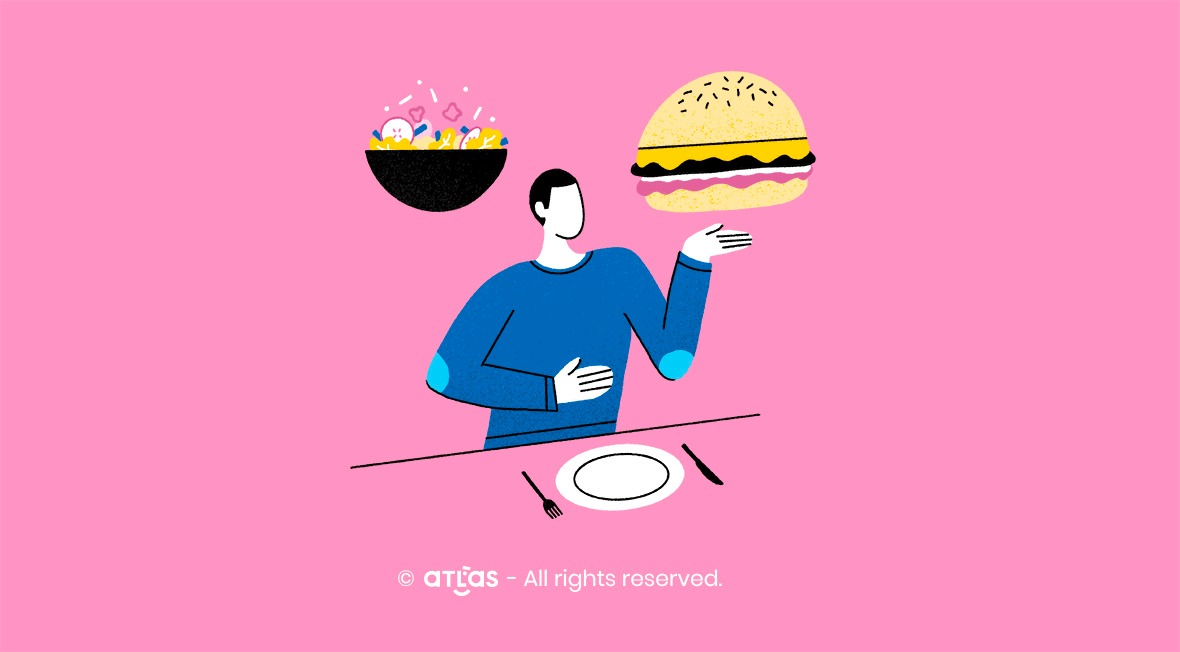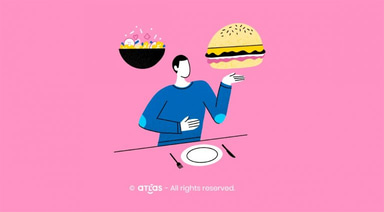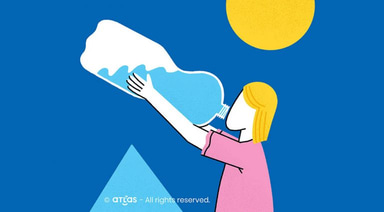Nearly 500,000 children in Romania could be affected by obesity by 2030, according to data from the World Obesity Federation. 1 in 4 children already has weight problems in Romania! Enormous! And in adults, we stay just as bad. 55% of the population is overweight.
What do we do, what do we do, when do we do it? How do we start when the scale starts arguing, and the mirror is left… Small for us? We discussed with the ATLAS nutrition specialist Ana-Paula Popiel about obesity. No curtains, no fuss. Obesity is a severe condition, and it must be treated. How? We’ll find out below!
Ms Doctor, I’ve gained a few extra pounds, I’m always tired when I make some effort, I’m not happy with the way I look when I look in the mirror, I’ve had sporadic pain in my spine, and I don’t know how to deal with this situation…
These are the words of a patient who suffers for five years of obesity and who is aware that the presence of excess pounds has changed his life.
To be aware of the situation, each of us needs some medical information that underlies the necessary change process.
What’s obesity?
Obesity is a nutritional-metabolic condition. It is characterized by excess accumulation of fats that cause a weight gain of more than 20% compared to the ideal weight. It is the most common metabolic condition and is a public health problem in most countries of the world.
Obesity “is visible.” It is a visible feature of the patient, while other metabolic diseases require specific biochemical determinations to be diagnosed.
Obesity occurs as a result of the imbalance between the body’s intake and energy consumption. In other words, it is due to an increased food intake relative to low energy consumption (food surplus over the body’s energy needs).
Let’s assess obesity!
Clinical examination of an obese patient shows generalized or localized fat deposition, stretch marks in the abdomen, or thighs. Associated are the symptoms of mechanical loading as:
- fatigue,
- polypnea dyspnea,
- edema of the lower limbs,
- joint pain.
At the skin level, irritation may occur in areas where it gives so-called “folds” by friction and increased sweating, pruritus, fungal, or bacterial superinfection. Nonspecific disorders such as vertigo, headache, menstrual disorders, flatulence, constipation are also present.
Paraclinical evaluation should include blood glucose, lipid profile, blood count, inflammation tests, renal and liver profile, hormonal dosing, functional tests, abdominal ultrasound, vascular doppler, X-rays, etc.
For the assessment of obesity, the measures include the body mass index (BMI) and abdominal circumference (CA). Other indicators that we can use to define obesity include the thickness of the skin fold (subscapular, triceps, biceps, etc.).
Body Mass Index
BMI is the most common method in medical practice for estimating the proportion of fatty tissue and is as follows:
BMI= body weight (kg)/ height2 (m)
The overweight patient has a BMI of 25-29.9kg/m2
According to the BMI criterion Obesity has three categories:
- Type 1- BMI 30-34.9 kg/m2
- Type 2- BMI 35-39.9 kg/m2
- Type 3- BMI greater than 40 kg/m2
Here’s the natural question, “Who should lose weight”?
The answer: all patients who are overweight or in one of the clinical classes are at moderate and severe risk. That’s because untreated obesity is progressing.
An important part of the management of this condition is the approach of comorbidities and complications arising as a result of weight gain.
Hypocaloric diet – a necessary step in the treatment of obesity
In general, a diet with a deficit of 500 calories/day compared to the previous dietary intake should be established. A weight loss of 5-10% of the initial weight is estimated over three months.
Establishing the hypocaloric diet must follow several essential principles:
- limiting food consumption outside set meals,
- fractionation of meals
- ensuring a nutritionally balanced diet
- establishment of foods the intake of which must be controlled
- avoiding/excluding high-calories food
- Stop smoking
- low alcohol consumption
Allowed foods:
- milk, yoghurt, skimmed cottage cheese
- lean cow meat, veal, lamb, poultry (chicken, turkey)
- lean fish – perch, pike, trout
- hard-boiled eggs, egg white
- mushrooms
- vegetables: tomatoes, radishes, endives, lettuce, sweet peppers, cucumbers, cauliflower, spinach, broccoli, asparagus, courgettes, white cabbage, green beans (how to prepare – as salads, boiled, smothered or as sautéed)
- fruit: sour apples, lemons, grapefruit, oranges, mandarins, watermelon, currants, strawberries, blueberries, raspberries, sour cherries, early cherries (the form of fruit salad or compote without added sugar or using sweeteners)
- fats: vegetable oils
- drinks: water, vegetable and fruit juices, skimmed milk
- salt: on average 5-8 grams per day
Liquids are provided in quantities of at least 1l 1/2 water per day. If a liquids restriction occurs (the patient does not consume sufficient liquids for various reasons), the low diuresis has a significant impact on the renal system in the first instance, then has an impact on the whole metabolism.
The following foods are prohibited:
- cheese, camembert, Schweitzer – in general, all fatty and salty cheeses, whole milk, fatty yoghurt, fatty cottage cheese;
- fatty meats, oily fish, canned meat and fish, fat sausages, smokes;
- bread and pasta;
- fried eggs;
- dried legumes: beans, peas, lentils, chickpeas;
- potatoes in large quantities;
- fruits: raisins, dates, figs, grapes, plums, hazelnuts, nuts, peanuts;
- fats: cream, bacon, fat, lard;
- sauces with raspberry, those with a lot of fat, mayonnaise;
- concentrated sweets, creams, fat doughs;
- liquids: sugar-sweetened beverages, syrups, alcohol, whole milk, coffee in large quantities.
The number of meals will be determined according to the patient’s profile, to ensure a more efficient metabolism of calories, preventing their accumulation in the form of adipose tissue.
If the patient suffers from constipation, short-term measures will be taken to solve this medical problem.
The patient should take from the start, into account the following recommendations :
- do not consume anything between the main tables; basically to give up snacks
- do not use excess salt
- not to drink alcohol
- comply precisely with the quantities of foods established by the diet – we must weigh everything we eat
- remove the sauces from the menu
- add healthy fats
- complete the diet with nutritional supplements if required. For example, Q10 coenzyme supplements help reduce the fat layer. Studies show that those who have been on a low-fat diet and took coenzyme Q10 have doubled their weight loss, compared to those who have only followed the recommended diet
- make a minimum of 30 minutes of exercise/walking etc. per day. It is necessary to increase physical activity, with an individualized submaximal effort, walking increases energy consumption by 300 kcal/hour. Exercise is essential not only for increasing energy consumption but also for combating insulin resistance.
Let’s not forget that there are also situations in which hypocaloric diets are not recommended.
- In pulmonary TB, Crohn’s disease, Addison’s disease, ulcer-hemorrhagic colitis, major depression, renal failure, gout, and very advanced age.
Relationship with the specialist is the basis of successful efforts.
The fundamental therapeutic principle in obesity management is the transformation of the positive energy imbalance into a negative energy imbalance. This transformation involves changing diet, eating behaviour, lifestyle, introducing sport into mandatory weekly activities – physical exertion made within individual tolerance.
It is necessary for the doctor together with the patient to establish and clearly define the objective and methods by which to achieve the desired weight loss. Without real cooperation between him and the doctor, efforts to lose weight will not be followed by success.
The weight loss will be phased at an individualized pace by the clinical, paraclinical, and psychological profile of the patient in question.
The therapeutic strategy of obesity should take into account all the factors that intervene in the etiopathy of the disease, from dietary behavior to the degree of obesity, the etiology of obesity, the complications, and comorbidities that accompany it.
Drug treatment for obesity
The medicinal treatment has only an adjuvant role and indicates in patients with a BMI greater than 30, with complications, to which hygienic-dietetic treatment has not worked. That’s why he represents a second-line treatment for obesity.
The drugs used can be grouped into medicines that produce the sensation of satiety, by mechanical distension of the stomach, drugs that inhibit the intestinal absorption of energy substances. These drugs inhibit intestinal lipase and drugs that inhibit the hunger centre of the hypothalamus.
The patient’s attention will be drawn to the risk of these medicines.
In addition to hygienic-dietetic treatment and drug treatment, specific surgical procedures, such as lipotomy, liposuction, and bypass, can also be used.
A periodic medical check-up is necessary for the supervision of the obese patient, evaluation of the results obtained, detection of complications, and adaptation of treatment to changes. If you don’t know how and when to start, you can contact Ana-Paula Popiel, ATLAS nutrition specialist, and she will help you with a plan specifically designed for your needs.
Take good care of yourself and those around you.
Love,
ATLAS


